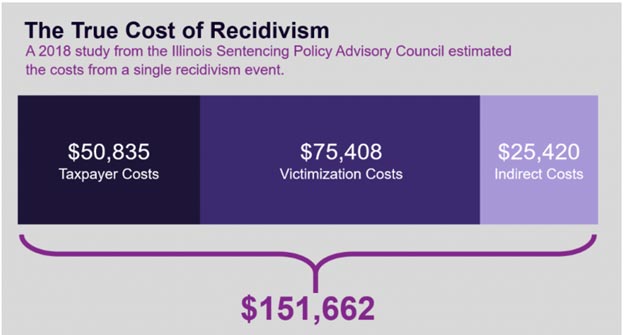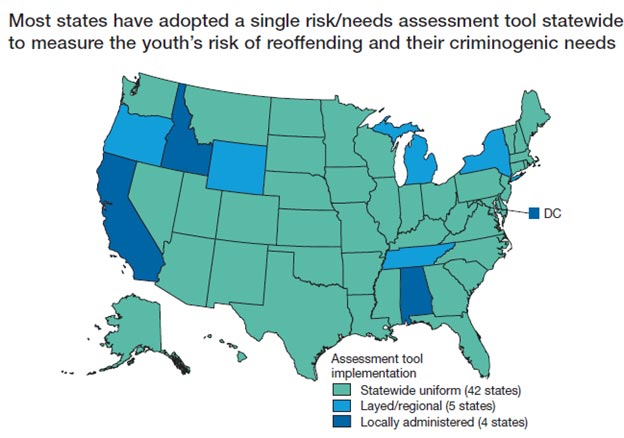As technology advances, there is a growing demand for electronic monitoring solutions that are both effective and sensitive to client needs.
In this post, we will discuss legislature that is happening across the U.S. for lower-risk adult populations and the juvenile justice system, as well as the unique features of BI VeriWatch®, a wrist-worn electronic monitoring device that offers a discreet and less intrusive approach to promoting compliance.
Discover how VeriWatch is reshaping supervision in Warren County. Download the article now.
The Cost-Benefit of Reducing Recidivism through Electronic Monitoring
Numerous studies have demonstrated the positive impact of electronic monitoring on reducing recidivism rates. For example, a study conducted by the Urban Institute1 provided a cost-benefit analysis that describes the costs of operating electronic monitoring and the savings to city and federal agencies and the benefit to society from reduced recidivism compared to standard probation.
Another study by the Florida Department of Corrections2 focused on the use of electronic monitoring for nonviolent clients. The results revealed a substantial decrease in recidivism rates among participants, further supporting the efficacy of electronic monitoring as a valuable tool in community corrections. Recidivism reduction is critical. According to a 2018 study3, the cost of a single recidivism event is more than $150,000.

A Growing Need for Monitoring Options
Ankle monitors have traditionally been the only option for supervising and tracking high-risk clients under supervision. However, many states are now exploring more discreet and flexible options for what the courts may rule as lower-risk adults and the justice-involved juveniles. Advancements in technology have paved the way for new alternatives that provide reliable, less intrusive solutions. A few states including California, Colorado, Illinois, Maine, New Jersey, New Mexico, Oregon, and Vermont4 have implemented laws about less restrictive electronic monitoring for community corrections.
Juvenile Justice System’s Shift Towards Alternative Detention Approaches
According to the Youth and the Juvenile Justice System: 2022 National Report5,in 2019, U.S. courts with juvenile jurisdiction handled an estimated 722,600 cases in which the youth was charged with a delinquency offense.
The report goes on to state, “as part of efforts to reduce the use of detention, jurisdictions may take steps to reduce the length of stay in detention. The fact that a youth was detained initially doesn’t mean they need to remain confined until their case is disposed. Efforts to find suitable alternatives to detention can enable the court to safely release the youth.”
This appears to be a nationwide trend that is quickly expanding the landscape of the justice system for all age groups, requiring more flexibility and options.

GPS Technology that Clients Can Wear with Confidence
VeriWatch, a discreet wrist-worn device, is designed to provide accurate real-time monitoring for individuals under community supervision. Similar in size to a consumer smartwatch, VeriWatch utilizes GPS and state-of-the-art technology to ensure reliable tracking and accountability. The device runs on a secure, custom operating system tailored to the unique needs and challenges of community supervision.
Key Features
- Enhanced Location Accuracy: VeriWatch combines GPS and Wi-Fi for precise location tracking.
- Biometric Facial Comparison: Real-time biometric facial comparison technology confirms client identity, enhancing security and tamper detection.
- Device Removal Detection: Proximity and sensor-based detection notify officers immediately of any attempts to remove the device, enabling prompt action.
- High-frequency Pursuit Mode: The high-frequency pursuit mode enhances tracking capabilities for urgent situations, aiding in swift intervention.
- Secure Custom App and Notifications: The secure, custom app enables officers to control device activity, send notifications, and promote better communication and compliance.
- Real-time Calendar Updates: The VeriWatch calendar feature provides real-time updates for appointments and program requirements, reducing violations.
Experience VeriWatch for Yourself–Request a Demo
Developed by BI Incorporated, VeriWatch is an integral part of our continuum of future-ready products and solutions aimed at strengthening communities and providing an alternative to detention. VeriWatch offers a new level of flexibility for lower-risk individuals while promoting accountability and helping reduce recidivism rates.
As community corrections looks to the future, BI is right there with you, continuing to develop and deliver cutting-edge products like VeriWatch. Our goal is to ensure that community corrections agencies have the resources they need to make a lasting impact in the lives of those under their supervision.
Discover how VeriWatch is reshaping supervision in Warren County. Download the article now.
1Urban Institute. ” The Costs and Benefits of Electronic Monitoring for Washington, D.C.” https://www.urban.org/sites/default/files/publication/25921/412678-the-costs-and-benefits-of-electronic-monitoring-for-washington-d-c-_1.pdf
2Florida Department of Corrections. “Florida Department of Corrections Electronic Monitoring Program Evaluation.” https://www.ojp.gov/pdffiles1/nij/234460.pdf
3State of Illinois Sentencing Policy Advisory Council, “The High Cost of Recidivism.” https://spac.icjia-api.cloud/uploads/Illinois_Result_First-The_High_Cost_of_Recidivism_2018-20191106T18123262.pdf
4California: California Penal Code Section 1203.017; Colorado: Colorado Revised Statutes Section 18-1.3-101; Illinois: Illinois Compiled Statutes Chapter 730, Article 5B; Maine: Maine Revised Statutes Title 17-A, Chapter 115; New Jersey: New Jersey Revised Statutes Title 2C, Chapter 43, Article 23; New Mexico: New Mexico Statutes Annotated Section 31-26-12; Oregon: Oregon Revised Statutes Section 137.730; Vermont: Vermont Statutes Annotated Title 13, Chapter 134.
5Office of Juvenile Justice and Delinquency Prevention. “Youth and the Juvenile Justice System: 2022 National Report.” https://ojjdp.ojp.gov/library/publications/youth-and-juvenile-justice-system-2022-national-report



